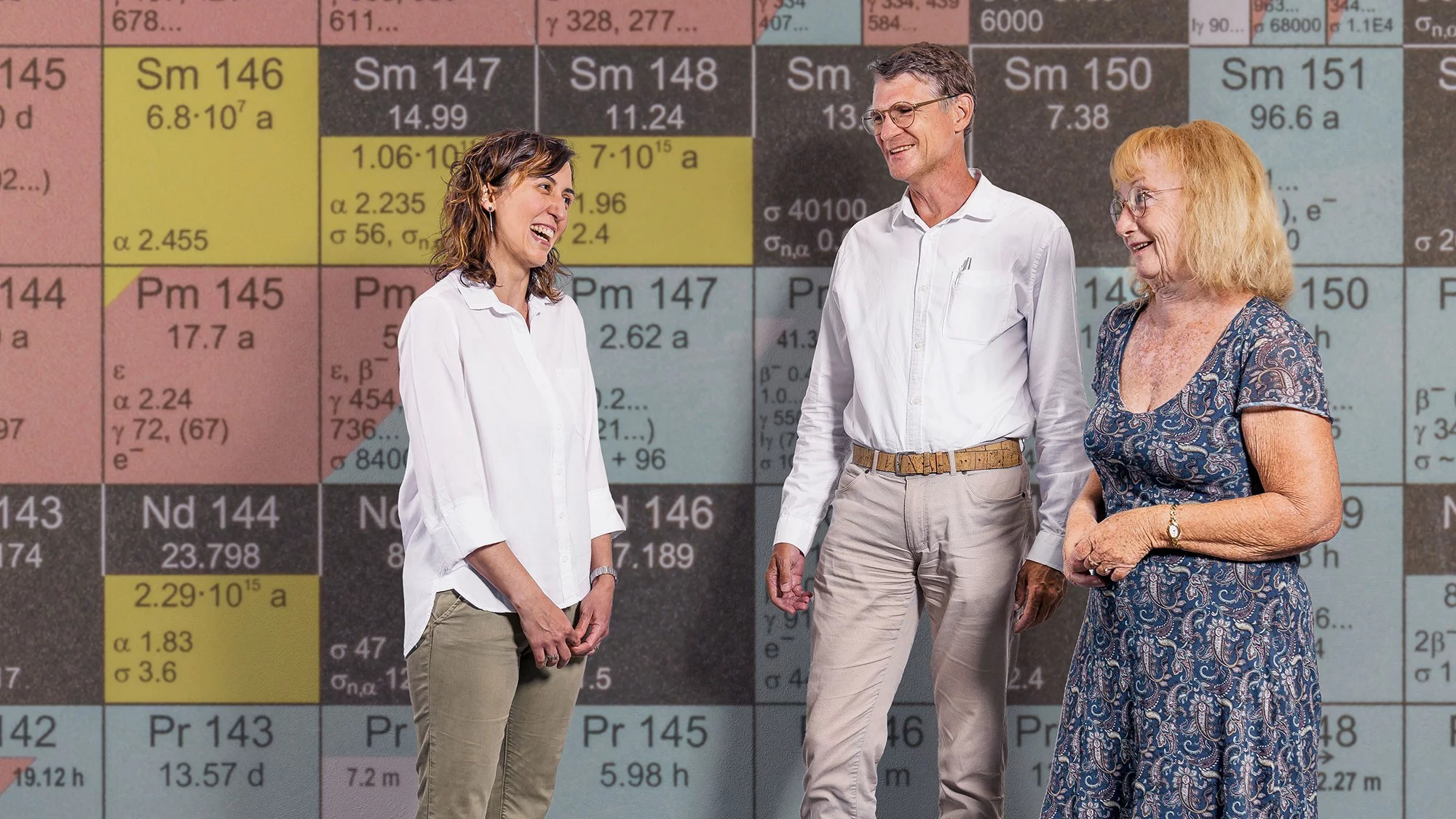Researchers at the Paul Scherrer Institute PSI and the Australian National University have re-determined the half-life of samarium-146 with great precision. The result fits perfectly with the data astrophysicists and geochemists have obtained from extraterrestrial samples. The study appears today in the journal Nature Scientific Reports.
Samarium-146 has a half-life of 103 million years. Or 68 million years. Or maybe 98 million years? Until now, it wasn’t known precisely, because researchers have repeatedly come up with contradictory results since the first measurements in the 1950s. For astrophysicists and geochemists, this is a major problem: They need to know the half-life of samarium-146 as accurately as possible to explain the formation of asteroids and planets and for dating rocks. Now their uncertainty is over. Samarium-146 has a half-life of 92 million years – which confirms very well with the age assessments of meteorites and moon rocks.
The most precise result to date
This result was achieved by a team of researchers from the Paul Scherrer Institute PSI in Villigen, Switzerland, and the Australian National University in Canberra. "Our result is the most precise to date," says Dorothea Schumann, who led the team. A fact also acknowledged by the peer reviewers who assessed the work: "This is an outstanding paper. It’s like Columbus’s egg," they wrote. They particularly highlighted that, in this publication, all steps were described in a comprehensible manner and thus the result is fully traceable. "I am impressed by the detailed documentation and quantification of possible artifacts," comments the expert report.
There are good reasons for this. In 2012, a team from Japan, Israel, and the USA published a surprisingly low value for the half-life of samarium-146: 68 million years, with an uncertainty of seven million years. That caused a worldwide consternation among geoscientists, as this value neither matched the older experiments nor the measurement data from meteorites used to date the formation of our solar system. Because no one could definitively conclude which of the outcomes was the more correct result, a team of experts recommended using this new value and the previously established value in parallel – an untenable situation for researchers. For moon rocks, for example, this would result in differences of 90 million years, which corresponds to around 35 percent of their formation age. Then relief came in 2023: The authors of the 2012 publication identified an inconsistency in one of the steps during the sample preparation and consequently withdraw their paper.
A problem postponed
With that, though, the problem was merely postponed. Geoscientists still required a more accurate value for the half-life of samarium-146 and some other radionuclides that play important roles in dating the formation of planets. What all these Radioisotopes have in common are half-lives of many millions of years. That’s how long it takes for half of the radioactive material to decay. Samarium-146 is a pure alpha emitter; the atom emits a helium nucleus and decays into neodymium-142. Because you obviously can’t wait millions of years for a significant amount of a material to decay, other methods are needed that can produce results more quickly.
In theory, that is quite simple. To determine the half-life of any radioactive isotope, you only need to determine the number of atoms in the sample as well as the activity, that is, the rate of decay. The quotient then gives the half-life up to a constant factor, the natural logarithm of 2. «Only» is a very optimistic little word here, however, because the path to determining the two values exactly is complicated and paved with experimental pitfalls. But the team found solutions for all of these challenges.
The experiment was divided into three parts. First came the extraction of sufficient quantities of the isotope samarium-146, which does not occur naturally on earth. For this purpose, tantalum samples irradiated at PSI's Swiss spallation neutron source SINQ turned out to be the most suitable material. After a series of highly selective chemical separations, an extremely pure solution of a samarium compound was obtained to produce a very thin sample for the activity measurement. Part of the solution was deposited on a carbon film only 75 micrometres thick.
Second, the activity measurement: The carefully prepared samarium sample was placed at a well-defined distance from an alpha radiation detector. The samarium film was only a fraction of a micrometer, so it would not stop the alpha particles. By determining the energy, the researchers could also discern whether or not an alpha particle actually came from the decay of samarium-146. The apparatus had been calibrated with a very precisely determined sample of americium-241 produced by the German Physikalisch-Technische Bundesanstalt PTB in Braunschweig. Because of the tiny amount of samarium-146 – even a grain of icing sugar weight 10 times more – the team had to carry out measurements for three months to determine the activity with sufficient precision; the rate was almost 54 decays per hour.
Third, determination of the number of atoms: Here the samarium solution was examined for its composition using various mass spectrometers at PSI and at the Australian National University by counting the number of atoms of samarium-146 as well as all other samarium isotopes present in the sample. After adding additional quantities of natural samarium, which contains no samarium-146, the total amount of all samarium isotopes and also of samarium-146 could be determined accurately. Because the mixture contained also an additional artificial isotope of samarium that emits gamma radiation, the researchers were able, to deduce how many samarium-146 atoms were deposited on the thin foil: exactly 6.28 times 1013 atoms or only 0,000018 milligram samariumoxide (146Sm2O3). In addition, the team was able not only to claim the high purity of the sample, but also to actually prove it through additional measurements. "This is the specialty of our lab at PSI, and the reviewers of our publication have particularly underlined it," says Rugard Dressler from the Laboratory for Radiochemistry.
Once all these experimental challenges had been overcome, the rest was a case for the pocket calculator. The result for the half-life of samarium-146 is 92.0 ±2.6 million years.
Only possible at PSI
These measurements were made entirely and exclusively feasible thanks to the ERAWAST initiative (Exotic Radionuclides from Accelerator Waste for Science and Technology), a long-term project funded by the Swiss National Science Foundation that reuses radioactive accelerator waste from PSI for research purposes. At PSI’s proton accelerator and the Swiss spallation neutron source SINQ, many radioactive isotopes are produced in various nuclear reactions. Most of these only cause serious issues through their radioactive decay and are therefore categorized as radioactive waste, but some of them are extremely rare and highly desired in fundamental research. The researchers of the Isotope and Target Chemistry group at the Laboratory for Radiochemistry at PSI, managed by Dorothea Schumann – project leader, initiator of the ERAWAST initiative and also co-author of the samarium paper – have developed techniques to chemically separate many isotopes of interest from the waste and to produce samples of high purity over the last 15 years. "Only in this way it was possible to obtain a sufficient amount of samarium-146 for the precise determination of its half-live – a possibility that is not available anywhere else around the world," says Zeynep Talip, who now heads the research group and is likewise a co-author of the samarium paper.
For Rugard Dressler, the work on samarium-146 is complete for now. For others, it’s just now getting started. The physicist from the Laboratory for Radiochemistry at PSI emphasises: "There is no finally correct value for the half-life of samarium-146. Our result is very precise indeed, but now it needs to be confirmed and if possible improved by other groups."
Contact
Original publication
-
Chiera NM, Sprung P, Amelin Y, Dressler R, Schumann D, Talip Z
The 146Sm half-life re-measured: consolidating the chronometer for events in the early Solar System
Scientific Reports. 2024; 14(1): 17436 (11 pp.). https://doi.org/10.1038/s41598-024-64104-6
DORA PSI
About PSI
The Paul Scherrer Institute PSI develops, builds and operates large, complex research facilities and makes them available to the national and international research community. The institute's own key research priorities are in the fields of future technologies, energy and climate, health innovation and fundamentals of nature. PSI is committed to the training of future generations. Therefore about one quarter of our staff are post-docs, post-graduates or apprentices. Altogether PSI employs 2300 people, thus being the largest research institute in Switzerland. The annual budget amounts to approximately CHF 460 million. PSI is part of the ETH Domain, with the other members being the two Swiss Federal Institutes of Technology, ETH Zurich and EPFL Lausanne, as well as Eawag (Swiss Federal Institute of Aquatic Science and Technology), Empa (Swiss Federal Laboratories for Materials Science and Technology) and WSL (Swiss Federal Institute for Forest, Snow and Landscape Research). (Last updated in June 2024)


